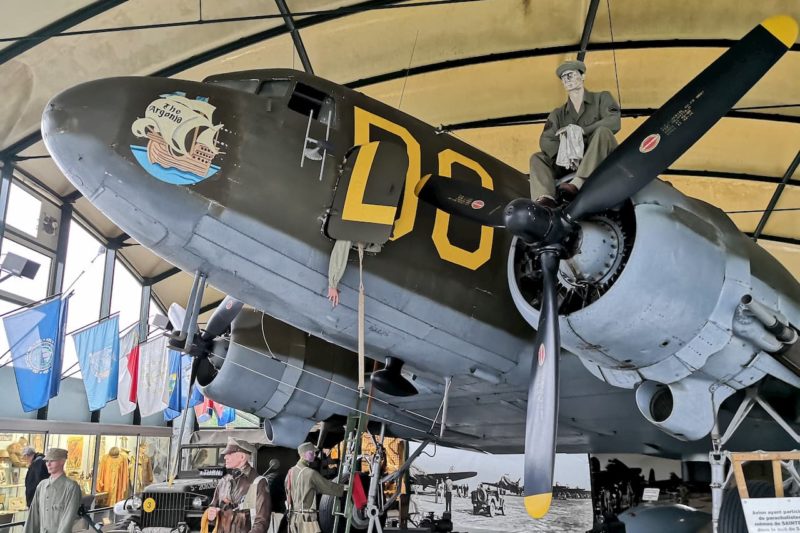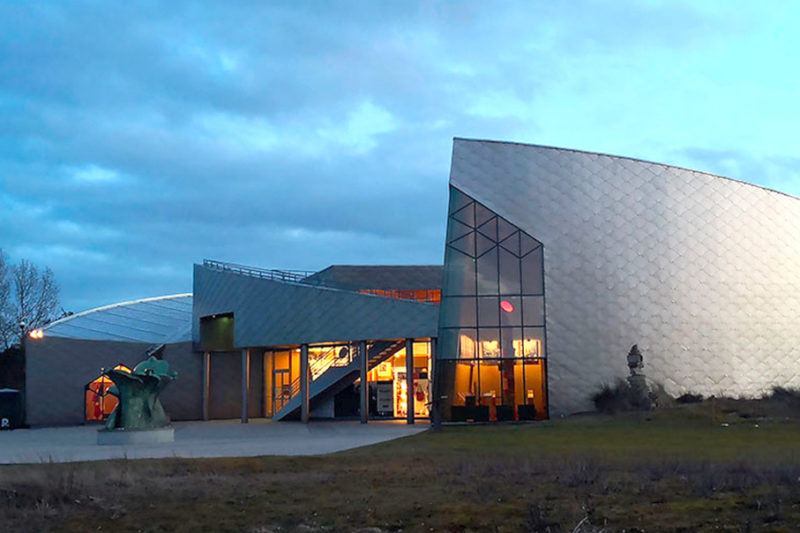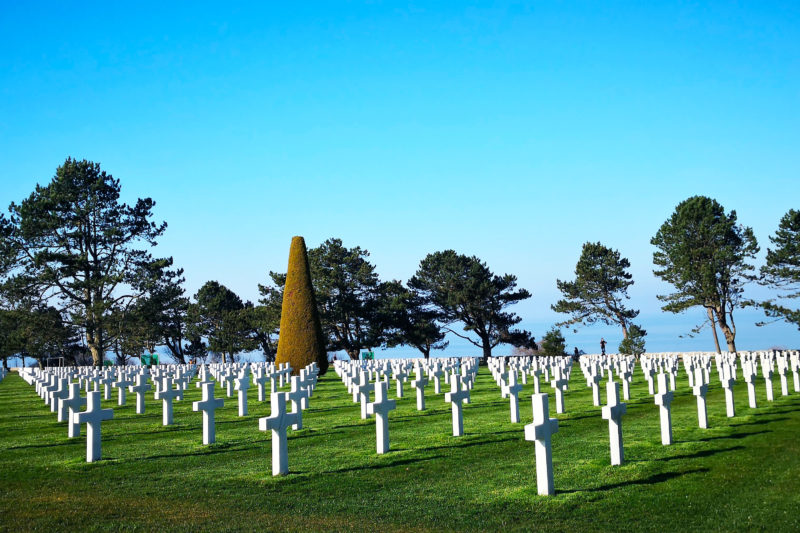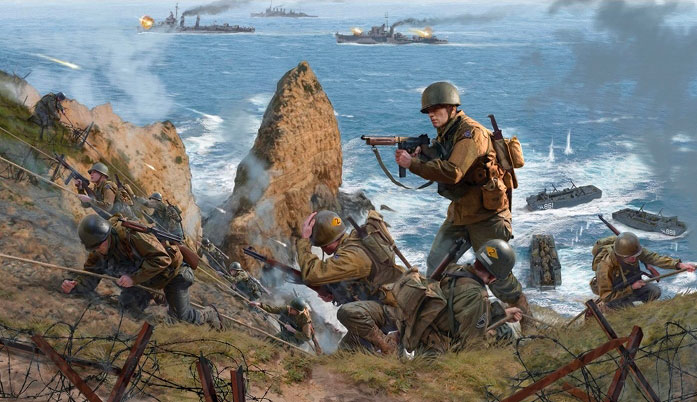Tour code : UTAH OMAHA D-DAY
 American Tour
American Tour
Normandy D-Day tour between Utah Beach, Sainte Mère Eglise, Omaha Beach, Normandy American Cemetery
Day trip from Paris to Normandy D-day U.S Landing beaches in a small group aboard a Minivan (max 7 participants)
- Information
- Tour Description
- Location
- Gallery
- Similar Tours
HIGHTLIGHTS
Visit to Normandy D-Day U.S battle sites and Memorials (Utah beach, Sainte Mère Eglise, Omaha beach and the Normandy American Cemetery) from Paris in a small group aboard a Minivan (Max 7 participants)
Step back in time on a history tour, and learn about the events of June 6, 1944
Walk along the dunes at « Utah beach » and see some german fortifications still standing and half buried in the sand.
Live the history of the Normandy invasion at Utah Beach Museum and see an authentic B26 bomber on display inside a Hangar!
See the famous church in Sainte Mère l’Eglise (With a dummy U.S paratrooper still hang from the steeple).
Admire some authentic WWII aircraft (Douglas C47 dakota) and glider (Waco CG 4A) on a base display at the Airborne Museum in Sainte Mère Eglise.
Walk along the « bloody beach » (Omaha) and pay your respect to the fallen U.S soldiers while visiting the Normandy American War Cemetery.
THE PRICE INCLUDES
- Small group tour (Max 7 participants)
- Travel aboard an air-conditioning Minivan vehicle
- Guided sightseeing tour with English-speaking guide
- Admission ticket to the Utah Beach D-day Museum, Sainte Marie du Mont (Utah Beach)
- Admission ticket to the Airborne Museum, Sainte Mère l’Eglise
THE PRICE DOES NOT INCLUDES
- Hotel pick-up and drop-off
- Food and drinks
- Gratuities
- Pickup in central Paris
- Introduction
- STOP 1 - UTAH BEACH (30mn)
- STOP 2 - UTAH BEACH D-DAY MUSEUM (45 MN)
- STOP 3 - LUNCH TIME AT "LE ROOSEVELT RESTAURANT", UTAH BEACH (45 MN)
- STOP 4 - LEADERSHIP MONUMENT (05mn)
- STOP 5 - IRON MIKE MONUMENT (10mn)
- STOP 6 - SAINTE MERE EGLISE CHURCH (20MN)
- STOP 7 - Airborne Museum in Sainte Mère Eglise (01 hour)
- STOP 08 - OMAHA BEACH – LANDING ZONE « EASY GREEN » – SAINT LAURENT SUR MER (20MN)
- STOP 09 - NORMANDY AMERICAN CEMETERY (01HOUR)
- Return and drop off in central Paris
In the morning the driver guide will pick you up at 06:30 am at the following adress : LIDO 116 Avenue des Champs-Elysées, 75008 Paris
(Easy to access by metro Line 1 and just get off at the Metro station « George V » or RER A « Charles de Gaulle Etoile)
This journey of one day trip in the Cotentin Peninsula in Normandy will embarks you in the footsteps of the brave americans soldiers (US 4th Infantry Div, US 82nd and US 101st Airbornes Divisions) who fought for our liberty so far away from their homelands.
Operation Neptune was the codename of the largest military' seaborne and airborne invasion for D-day ever organized. Military operations began shortly after midnight, on June 6th 1944, with around 156,000 allies troops landing
During that day, you will discover not only one of the most important episodes in modern history (so well related in the movie «The Longuest Day and TV Mini-Series « Band Of Brothers ») but also beautiful countrysides (known as « le bocage ») in one of the historical' oldest and greatest region of France .
With your driver-guide you will travel to Normandy in an air-conditioning minivan. Once you arrive in the Cotentin Peninsula in Normandy, you will stop at « Utah Beach » which was one of the two American landing zones in Normandy. This beach was created by British general Bernard Montgomery who wished to establish a beachhead directly in the Cotentin peninsula in order to capture Cherbourg faster, because of its deep water harbor and its major logistic importance.
The amphibious assault, primarily by the US 4th Infantry Division and 70th Tank Battalion, was supported by airborne landings of the 82nd and 101st Airborne Division. The 4th Infantry Division landed 21,000 troops on Utah at the cost of only 197 casualties. Airborne troops arriving by parachute and glider numbered an additional 14,000 men, with 2,500 casualties.
To commemorate their bravery and sacrifice,severals war monuments were erected there directly on the sand of the beach after the war. Around the monuments, german concrete bunkers, shell holes and traces of the battle are still visibles today. (photo stop on the spot) :
.Monument of the 4th Infantry Division
.The 90th Infantry Division Monument
.U.S Navy Monument
.Milestone 00
At Utah beach, you will have time to walk along the dunes and while you will take a look at sea just to imagine in your mind the hundred of american war ships and Landing Craft Assault who came offshore Utah Beach on D-day.
Built on the very beach where the first American troops landed on June 6, 1944, the Utah Beach Museum recounts the story of D-Day in 10 sequences, from the preparation of the landing, to the final outcome and success. This comprehensive chronological journey immerses visitors in the history of the landing through a rich collection of objects, vehicles, materials, and oral histories.
Admire an original B26 bomber, one of only six remaining examples of this airplane still in existence worldwide, and relive the epic experience of American soldiers through the film “VICTORY IN THE SAND,” winner of a CINE GOLDEN EAGLE AWARD 2012 and the 2013 CINE SPECIAL JURY AWARD for best museum documentary.
By the end of your visit, you will understand the strategic choices for the Allied invasion of Normandy and the reasons for the success at Utah Beach. Thanks to your visit, you will also have contributed to the safeguard of the site and the preservation of the memory of the Allied soldiers’ extraordinary sacrifices.
The German Defense
This gallery is housed in one of the original German bunkers that defended Utah beach on D-Day. Known as “WN5,” the strongpoint was a part of the famous Atlantic Wall, the defensive system constructed under the supervision of Field Marshall Erwin Rommel beginning in February 1943 to protect against a possible landing of Allied troops in Europe. Stretching from Norway to Spain, the Atlantic wall was made up of a series of fortifications and bunkers and was defended by extensive minefields and miles of trenches and barbed wires. Many remnants of the Atlantic Wall can still be visited around the Museum.
Arthur Jahnke, a 23-year old lieutenant, was responsible for the defense of the WN5 with his 75 men. On the morning of June 6, 1944, they would be the first defenders that the Allied forces would confront.
This exhibit features German weapons and military equipment from the Utah Beach sector, as well as everyday objects used by the German soldiers. Visitors can also discover a rare wire-guided “Goliath” miniature tank found by American troops at Utah Beach.
The Contentin under occupation
Learn about daily life for the local population during the dark years of the German Occupation.
On June 18, 1940, the German soldiers of the 7th Panzer Division led by Erwin Rommel enter the town of Sainte Marie du Mont. This marks the beginning of four years of deprivation, intimidation, and requisitions.
Referring to these dark years, local resident and founder of the Museum Michel de Vallavieille would recall, “We had a miserable life, a life that become increasingly harder and more miserable as time went by.”
Oral histories, artifacts, and personal documents attest to the difficulty of life under occupation.
June 6 1944 : D-Day at Utah Beach
After a night at sea, crammed into landing barges, sickened by the rough seas and exhausted by hours of waiting, the 860 men of the 4th Infantry Division land on the beach at H-Hour: 6:30 A.M. on the morning of June 6, 1944. They are followed by the men of the 90th Infantry Division.
The crossing of this beach seems endless. After wading through 220 yards in water, weighted down by 70 lbs of equipment on their backs, the soldiers have to run another 550 yards under fire from the German artillery.
Fortunately, the actions of Air and Naval Forces have greatly weakened the enemy lines, enabling the Americans to reach the protection of the anti-tank wall on the beach in just half an hour.
A few minutes after H-Hour, 29 Duplex Drive amphibious Sherman tanks from the 70th Tank Battalion land on the beach. The D-Day landing at Utah Beach is a success!
However, in the confusion of the first moments of the landing, it becomes apparent that the GIs in the first waves have landed 2 kilometers south of the sector originally planned. Brigadier General Theodore Roosevelt Jr. will make the key decision to engage his men by moving inland rather than attempt to relocate to the planned landing site. He famously declares, “We’ll start the war from here.”
By nightfall of June 6, 1944, 23,000 men have landed on Utah Beach.
Today, one of the iconic elements of D-Day is the LCVP assault barge, nicknamed the “Higgins Barge.” The Museum houses the only known original LCVP to have participated in the D-Day landings.
On the second floor of the Museum, a gallery featuring numerous oral histories and several major artifacts open onto a spectacular panoramic view of Utah Beach.
June 6 1944 : D-Day at Utah Beach
The Roosevelt was a simple fishing house sheltered in the dunes. From 1942 to June 1944, it served as an office for the organization Tod. An adjoining bunker probably served as a telephone exchange for the German army.The bunker was home to the US First Engineer Brigade, and from June to November 1944 the US Navy’s communications centre was responsible for traffic between the fleet and the front.
On the walls of this bunker, the signatures of these men are the living testimony of their presence more than 70 years ago. These 39 radio operators were members of the N.O.I.C (Naval Officer In Charge) and belonged to the Commando Task Group 127.2. Inside the bunker, reconstruction of the communication center of the time.
The World War II Foundation selected Major “Dick” Winters of Easy Company as a symbol of leadership. This monument honors the combat leadership of the American troops during Operation Overlord.
Located along the strategically important road between Utah Beach and Sainte Marie du Mont. The sculpture of Winters leads in the direction of the upcoming battles.
The Iron Mike memorial is a statue of an American paratrooper. It is named after St Michael, a saint of the Airborne. The memorial is a replica of the one at the U.S. Army Infantry School in Fort Benning USA. The Iron Mike memorial was unveiled on June 7, 1997 by Major-General Kellogg, commander of the 82nd Airborne who made a jump with his men that day out of a plane.
Jumping on the night of D-Day, the 82nd Airborne had to capture the town of Sainte-Mère-Église. Holding the town, however, would have meant little without also holding the roads to and from it. One such route had a bottleneck: the La Fière Bridge a small stone bridge at
La Fière manor, 700 yards to the west of the outskirts. The manor itself was a small group of buildings a grenade-throw away from the bridge. On the far side of the bridge, the road led west, the small hamlet of Cauguigny standing by it two-thirds of a mile away.
Securing La Fière Bridge fell to the 505th PIR. The 1st Battalion was one of the few units that night to jump on time and land in its designated drop zone to the east of the bridge, between it and the town. They quickly learned that things were not as expected: the Germans have flooded large areas of Normandy and the tiny Merderet River running north-south under the bridge was now a marsh 1,000 yards across at its narrowest. The elevated road between the bridge and Cauguigny became a causeway surrounded by water, providing no cover.
Sainte Mere Eglise became known to the world after the film The Longest Day because of the paratrooper John Steele of the 505th Parachute Infantry Regiment.
Steele indeed landed on the church's steeple and pretended to be dead in order to avoid being shot by the Germans.
He stayed put, hanging in the air, for two long hours and watched helplessly as the Germans shot his comrades around him.
Nowadays the Church is still standing in the middle of the town square.
The municipality of Sainte Mère l’Eglise has hung a dummy US paratrooper and his parachute on the steeple of the church and so has found the finest tribute that could be given to John Steele and all his comrades who lost their lives under German bullets.
In addition, two stained glass windows were created for the church, in order to commemorate the liberation of the town by 82nd Airborne Division on June 6,1944.One of them depicts the Virgin with two paratroopers and the second one is Private John M. Steele (1912–1969)
Live the history of the Normandy invasion at the Airborne Museum !
At the heart of Sainte-Mère-Eglise, facing the church where John Steele famously was caught, hanging from the bell tower by his parachute. The Airborne Museum makes you live and understand the D-Day from the invasion preparations in England, through to the battles for liberation.
Few miles from Normandy landing beaches, the Airborne Museum has become the largest museum in Europe dedicated to the american paratroopers of the 82nd and 101st Airborne engaged in the context of the Normandy invasion in 1944, during the Second World Word.
Board on mythic planes and discover historic items which bring you in June 1944. The Museum will bring you into the history of Sainte-Mère-Eglise thanks three buildings and very soon four buildings :
The Waco Building
The first area of the Museum is devoted to Gliders and their use during the Invasion in Normandy.
The Airborne Museum presents the unique sample in France of a WACO glider. You will join a dozen soldiers in the glider few moments before the take off.
Discover these planes without motor which were essentials to carry on men and materials. More than 500 gliders were deployed on Norman soil on D-Day and the following days. They carry on vehicles, ammunitions and other equipments about 4 400 soldiers boarded on gliders during Normandy invasion.
The C-47 Building
Attend the preparation of the largest military operation ever carried out!
In England, on the 5th of June 1944, in an airfield tarmac at the foot of a C-47 aircraft which was deployed in the D-Day parachute drop operations, review the troops with The General Eisenhower just before Invasion and the Battle of Normandy.
Operation Neptune
The brand new building « Operation Neptune » will make you experience a night jump as if you were there !
SENSATIONS AND FEELINGS GUARANTEED !
Through a hyperrealist museography, join the nighttime embarkation of a C-47 aircraft in England, then drop into the square of Sainte-Mère-Eglise in the midst of the fighting and take part in the operations that followed.
Finally you will discover an American reconnaissance plane: a Piper Cub.
Get into the minds of the troopers and feel the intensity of the combat.
At Easy Green sector, two monuments were erected after the war and still stands facing the beach : Monument « Signal of the Liberation » (photo stop on the spot) This Monument commemorates the landing of the Allied Forces on June 6, 1944 on Omaha Beach, and the liberation of Europe. Two frescoes can be seen on either side of the monument, one dedicated to the 1st US Infantry Division, the other at the 116th Regimental Combat Team of the 29th US Infantry Division Monument « The Braves » (photo stop on the spot) A monumental work by sculptor Anilore Banon which pay tribute to the courage of Allied Forces soldiers. There you will have a bit of time to walk along the beach and maybe grabb a bit of sand to fill in a tiny glassed container as a souvenir to bring back home.
The guide is now taking you to visit the beatiful maintained American Cemetery in Colleville sur Mer which overlooks Omaha Beach nearby. The 180 acre site contains 9,387 perfectly aligned white crosses and a memorial chapel which adds the finishing touches to this moving scene, allowing visitors to reflect on the price of war.
While walking along row upon row of white grave headstones, your historian guide will share with you stories of soldiers who fought in the vicinities and then were awarded for gallantry the highest miltary decorations.
On the Walls of the Missing, in a semicircular garden on the east side of the memorial, are inscribed 1,557 names. Rosettes mark the names of those since recovered and identified.
The memorial consists of a semicircular colonnade with a loggia at each end containing large maps and narratives of the military operations; at the center is the bronze statue, “Spirit of American Youth Rising from the Waves.” An orientation table overlooking the beach depicts the landings in Normandy. Facing west at the memorial, one sees in the foreground the reflecting pool; beyond is the burial area with a circular chapel and, at the far end, granite statues representing the United States and France.
In 2007, the Normandy Visitors Center opened. The $30 million visitor center was dedicated by the American Battle Monuments Commission (ABMC) on June 6, 2007 during the commemoration of the 63rd Anniversary of D-Day.
During the return drive to Paris you will have time to relax aboard the minivan before to be dropped off in Central Paris (Drop off in front of the "LIDO DE PARIS 116 Av. des Champs-Élysées, 75008 Paris" in the evening between 07:30 pm till 08:30 pm).
Easy there to catch a taxi cab either to find metro station (Ligne 1 Métro : George V).





